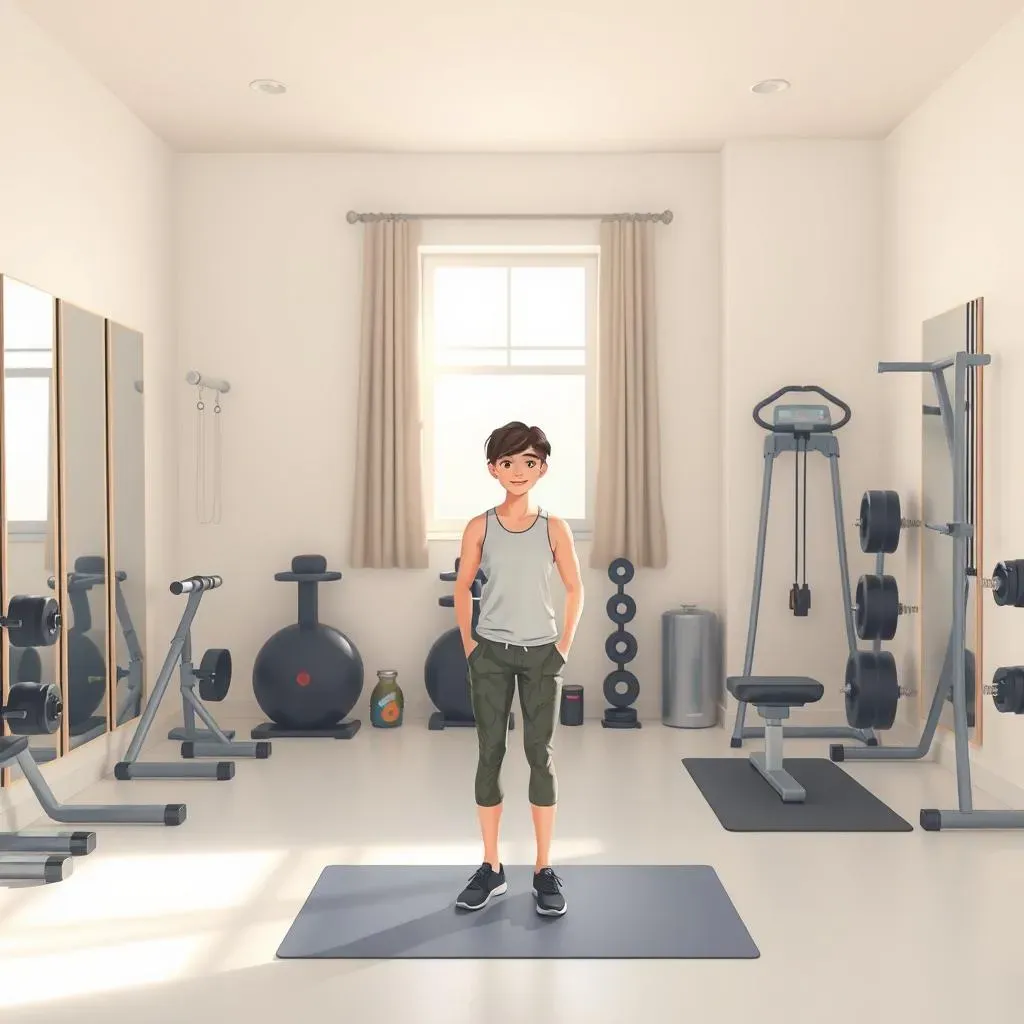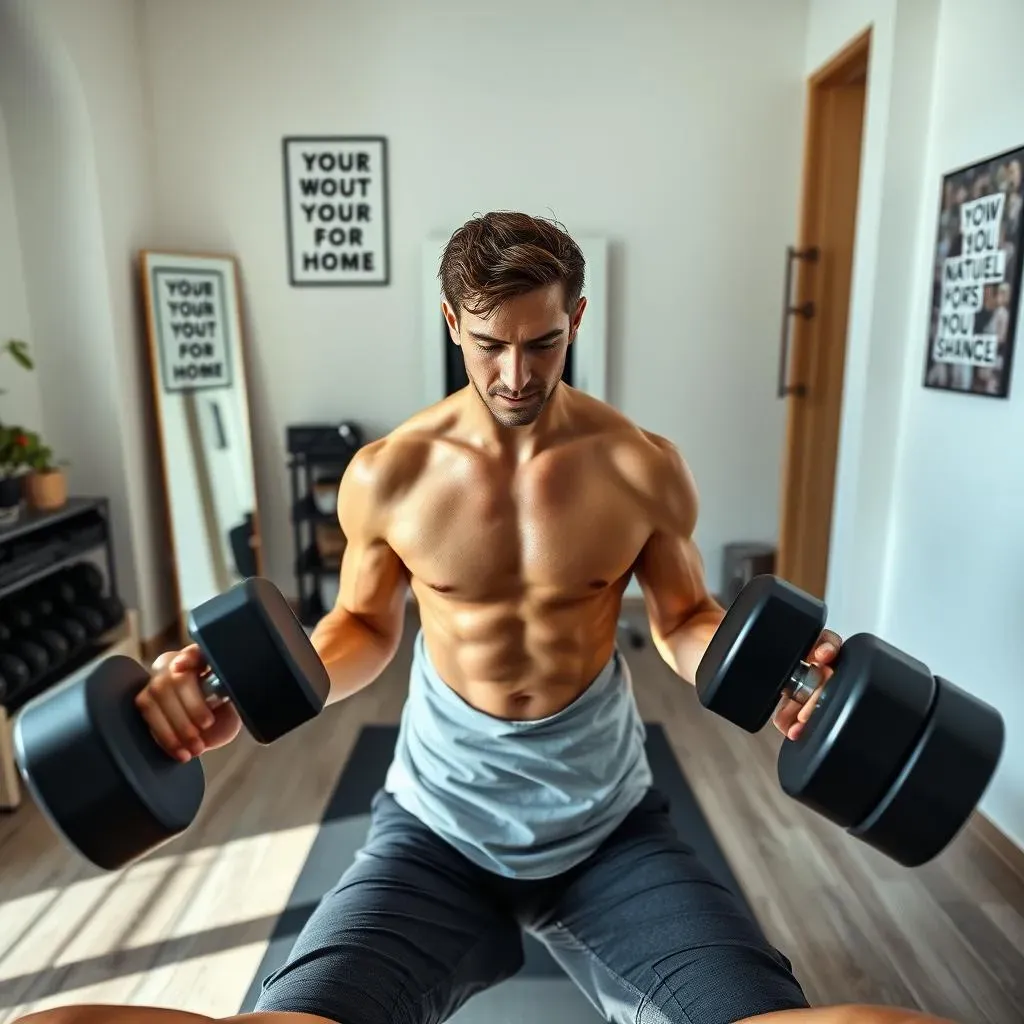Table of Contents
Stuck at home but still want to torch calories and build strength? Forget those crowded gyms and complicated equipment. You can achieve amazing results with the **best workout for full body at home**, and guess what? It doesn't require fancy gear or hours of your time. This guide will hand you a killer 30-minute routine designed to hit every major muscle group, using just your body weight and maybe a set of dumbbells if you're feeling ambitious. We'll start with essential safety tips to keep you injury-free, then walk you through a proper warm-up to get your muscles ready. Next, we'll dive into the workout itself, breaking down each exercise with clear instructions. But it doesn't stop there! Learn how to progress your workout as you get stronger, the importance of cooling down, and even some nutrition tips to fuel your fitness journey. Ready to transform your living room into your personal gym? Let's get started!
Safety First: Your Guide to InjuryFree Home Workouts

Safety First: Your Guide to InjuryFree Home Workouts
Listen to Your Body's Whispers (Before They Become Shouts)
Ever pushed through a pain that felt a little "off"? Yeah, we've all been there. But when you're your own gym boss at home, nobody's watching to tell you to chill. That twinge in your shoulder during push-ups? Don't ignore it, thinking you're toughing it out. It's your body's way of saying, "Hey, something's not right!" Learning to distinguish between the good burn of a workout and actual pain is key. Pushing too hard, especially when starting, is a surefire way to sideline yourself. Think of your body as a car – you wouldn't redline it constantly, would you? Same goes for your muscles and joints. Start slow, focus on form, and respect your limits. Trust me, your future self will thank you for those rest days and modifications.
Your Workout Space: Clear the Runway for Gains
Picture this: You're crushing your squats, feeling the burn, and then BAM! You trip over the cat. Hilarious for the internet, terrible for your ankle. Before you even think about your first jumping jack, scan your workout area. Is there enough room to move freely without bumping into furniture? Are there any rogue toys, slippery rugs, or overenthusiastic pets that could become obstacles? Good lighting is also crucial. You need to see what you're doing and avoid any unexpected hazards. Think of it as preparing a stage for your awesome workout performance. A clear, well-lit space minimizes distractions and, more importantly, prevents unnecessary trips and falls. Plus, a tidy workout zone just feels better, doesn't it?
Form Over Everything (Yes, Really)
We all want results, like, yesterday. But rushing through exercises with sloppy form is like building a house on a shaky foundation. It might look okay at first glance, but it's bound to crumble. Proper form ensures you're working the intended muscles effectively and, crucially, protects your joints from unnecessary stress. Think of a squat: knees tracking over your toes, chest up, back straight. It might feel awkward at first, especially if you're used to just "going through the motions." But mastering the correct technique, even with fewer reps or lighter weights, is far more beneficial in the long run. There are tons of great resources online – videos, articles – that demonstrate proper form for various exercises. Don't be afraid to use a mirror to check yourself or even record yourself to identify areas for improvement. Remember, quality trumps quantity when it comes to building strength and avoiding injury.
- Start with bodyweight exercises to master form.
- Watch videos and read articles on proper technique.
- Use a mirror to check your alignment.
- Don't be afraid to modify exercises if needed.
- Listen to your body and stop if you feel sharp pain.
WarmUp: Preparing Your Body for the Best Full Body Workout at Home

WarmUp: Preparing Your Body for the Best Full Body Workout at Home
Why Bother Warming Up? It's Like Foreplay for Your Muscles
Seriously though, skipping the warm-up is like trying to sprint in jeans straight out of bed. Your muscles are stiff, your joints are creaky, and you're just asking for trouble. A good warm-up isn't just some formality; it's about getting your body ready to rock. Think of it as sending an invitation to your muscles, telling them, "Hey, we're about to do some cool stuff, so wake up and get the blood flowing!" It increases blood flow to your muscles, which means more oxygen and nutrients getting where they need to be. Plus, it gets your joints moving through their full range of motion, reducing the risk of strains and sprains. Trust me, those few extra minutes you spend warming up will pay off big time by allowing you to push harder and stay injury-free during your actual workout.
Your Go-To Warm-Up Moves: Keep It Simple, Keep It Moving
You don't need some elaborate dance routine to get warmed up. The best approach is to choose dynamic movements that mimic what you'll be doing in your workout. Think arm circles to loosen up your shoulders for those push-ups, leg swings to prep your hamstrings for squats, and torso twists to get your core ready. Light cardio, like jogging in place or jumping jacks, is also a fantastic way to raise your heart rate and body temperature. Aim for about 5-10 minutes of this kind of movement. The goal isn't to exhaust yourself before you even start, but to gently ease your body into action. It's like turning up the volume slowly instead of blasting it all at once – a much smoother and more enjoyable experience for everyone involved (especially your muscles!).
- Arm circles (forward and backward)
- Leg swings (forward and sideways)
- Torso twists
- High knees
- Butt kicks
- Jumping jacks
The Ultimate Full Body Workout You Can Do at Home

The Ultimate Full Body Workout You Can Do at Home
Bodyweight Basics: Your Foundation for Fitness
Alright, let's get to the good stuff – the workout itself! We're kicking things off with bodyweight exercises. Why? Because they're awesome for building a solid foundation. You don't need any fancy equipment, and you can do them pretty much anywhere. Think of these as the building blocks of your fitness journey. We're talking squats to work those legs and glutes, push-ups for your chest and triceps (don't worry if you start on your knees!), and lunges to sculpt your legs and improve balance. These moves might seem simple, but when done correctly, they are incredibly effective. Focus on your form – remember what we talked about earlier? Quality over quantity, always. Start with a manageable number of repetitions, like 8-12, and focus on feeling the right muscles engage. You can always add more reps or sets as you get stronger.
Amping It Up: Adding Dumbbells to the Mix
Ready to take things up a notch? Grab those dumbbells! Even a light set can make a big difference. We're going to use them to add resistance and challenge your muscles further. For your legs, try dumbbell squats or lunges, holding a weight in each hand. For your upper body, dumbbell rows are fantastic for your back, and overhead presses target your shoulders. Bicep curls and triceps extensions will help sculpt your arms. Again, focus on controlled movements and proper form. Don't go too heavy too soon. It's better to start with a weight you can manage with good form for the recommended reps (again, aim for 8-12 to start). Think of those dumbbells as your workout buddies, adding a little extra challenge to help you grow stronger.
Exercise | Target Muscles | Reps (Beginner) | Reps (Intermediate/Advanced) |
|---|---|---|---|
Bodyweight Squats | Quads, Glutes, Hamstrings | 10-15 | 15-20 |
Push-ups (on knees or toes) | Chest, Triceps, Shoulders | 5-10 | 10-15 |
Lunges (alternating legs) | Quads, Glutes, Hamstrings | 8-12 per leg | 12-15 per leg |
Dumbbell Rows | Back, Biceps | 8-12 per arm | 12-15 per arm |
Overhead Press | Shoulders | 8-12 | 10-15 |
Bicep Curls | Biceps | 10-15 | 12-18 |
Triceps Extensions | Triceps | 10-15 | 12-18 |
Core Crushers: Don't Forget Your Center
A strong core is essential for everything, from good posture to preventing injuries. So, we can't forget to give those abs some love! Planks are a fantastic exercise for building overall core strength. Focus on keeping your body in a straight line from head to heels, engaging your abs. Crunches, bicycle crunches, and leg raises are also great options for targeting different parts of your core. Don't just go through the motions; really concentrate on squeezing your abdominal muscles during each repetition. Think of your core as the powerhouse of your body – keeping it strong will benefit you in all aspects of your fitness journey and everyday life. Aim for a few sets of these core exercises at the end of your workout to really finish strong.
Progressing Your Home Workout: Making it Harder

Progressing Your Home Workout: Making it Harder
Level Up Your Reps and Sets: The Workoutdometer
So, you're no longer winded after those bodyweight squats, huh? That's awesome! It means it's time to crank up the intensity. Think of your reps and sets as the mileage on your fitness journey. If you're always doing the same number, you're just cruising in neutral. A simple way to make your workout harder is to increase the number of repetitions you perform for each exercise. If you were doing 10 squats, try for 12 or 15. Similarly, bump up the number of sets. Instead of two sets of push-ups, aim for three. It's like adding extra weight without actually adding weight! This gradual increase challenges your muscles more, leading to greater strength and endurance. Just remember, listen to your body, and don't jump from 10 reps to 30 overnight. Small, consistent increases are the key here.
Tempo Training: Slow and Steady (and Surprisingly Tough) Wins the Race
Ever thought about *how* you're doing an exercise, not just how many? That's where tempo training comes in. It's about controlling the speed of each part of the movement. For example, during a squat, instead of just dropping down and popping back up, try slowing down the descent – count to three as you lower yourself. Then, explode back up. This controlled movement increases the time your muscles are under tension, making the exercise significantly harder. Trust me, those slow, controlled reps will feel way more challenging than just rushing through them. It's like the difference between a leisurely stroll and climbing a hill – both are walking, but one is definitely more demanding. Experiment with different tempos for different exercises. You'll be surprised at how much harder it makes things!
Progression Method | How it Works | Example |
|---|---|---|
Increase Reps | Do more repetitions per set. | Go from 10 to 15 push-ups. |
Increase Sets | Do more sets of each exercise. | Do 3 sets of squats instead of 2. |
Tempo Training | Control the speed of each movement. | Lower slowly for 3 counts during a squat. |
Cooling Down and Recovery: Essential After Your Best Full Body Workout

Cooling Down and Recovery: Essential After Your Best Full Body Workout
Why Cool Down? It's Not Just an Afterthought
You wouldn't just slam on the brakes after a high-speed drive, right? Same goes for your body after crushing your **best workout for full body at home**. A cool-down isn't some optional extra; it's a crucial step in helping your body transition back to its resting state. Think of it as gently landing a plane after a flight. Suddenly stopping intense exercise can cause blood to pool in your legs, leading to dizziness or even fainting. A proper cool-down, with light cardio like walking or marching in place, helps your heart rate and breathing gradually return to normal. Plus, it starts the process of flushing out metabolic waste products, like lactic acid, which can contribute to muscle soreness. Don't skip this important step – your body will thank you for it tomorrow!
Stretch It Out: Showing Your Muscles Some Love
Once your heart rate is back to a reasonable pace, it's time to stretch. Think of stretching after a workout as giving your muscles a nice, long hug. Focus on holding each stretch for about 20-30 seconds, and concentrate on the muscles you just worked. So, after squats and lunges, stretch your quads, hamstrings, and glutes. After push-ups, stretch your chest and triceps. Gentle, static stretches – where you hold the position without bouncing – are ideal post-workout. This helps improve flexibility, reduces muscle stiffness, and promotes blood flow, aiding in recovery. It's like ironing out the wrinkles in your muscles after a tough workout. Plus, it just feels good, doesn't it?
Cool-Down Activity | Duration | Benefits |
|---|---|---|
Light Cardio (walking, marching) | 5-10 minutes | Gradually lowers heart rate, prevents blood pooling |
Static Stretching | 20-30 seconds per stretch | Improves flexibility, reduces muscle stiffness |
Fueling Your Body: Nutrition for Workout Success

Fueling Your Body: Nutrition for Workout Success
Eat Like You Mean It: Fueling Up for Your Fitness Goals
so you're putting in the work with your awesome home workouts, that's fantastic! But here's the thing: you can't expect a Ferrari to run on cheap gas, right? Same goes for your body. Nutrition is like the secret weapon that unlocks your workout's full potential. Think of food as fuel – the better the fuel, the better your performance and recovery. We're not talking about restrictive diets here, but rather about making smart choices to nourish your body. Focus on whole, unprocessed foods. Load up on colorful fruits and veggies – they're packed with vitamins and minerals your body craves. Lean protein sources like chicken, fish, beans, and lentils are crucial for muscle repair and growth. And don't be afraid of healthy carbs like brown rice and quinoa for sustained energy. It's about creating a balanced plate that supports your fitness goals, not sabotages them.
Timing is Everything: When to Eat for Maximum Benefit
Ever tried working out on an empty stomach and felt like you had zero energy? Or maybe you ate a huge meal right before and felt sluggish and nauseous? Yeah, timing your meals around your workouts can make a big difference. Think of it like this: you need to fuel up before your workout to have the energy to push through those reps. A small meal or snack containing carbs and a little protein about an hour or two beforehand is a good idea. Think a banana with peanut butter or some yogurt with berries. Then, after your workout, it's time to refuel and help your muscles recover. Aim for a meal or snack with protein and carbs within an hour or so after you finish. This helps replenish your energy stores and kickstarts muscle repair. It doesn't have to be complicated; a protein shake with fruit or a chicken breast with sweet potato works wonders. It's all about giving your body what it needs, when it needs it, to get the most out of your efforts.
Meal Timing | What to Eat | Why |
|---|---|---|
Pre-Workout (1-2 hours before) | Banana with peanut butter, yogurt with berries, small oatmeal | Provides energy for your workout |
Post-Workout (within 1 hour after) | Protein shake with fruit, chicken breast with sweet potato, eggs with whole-wheat toast | Replenishes energy and aids muscle recovery |
Wrapping Up Your Best Full Body Workout at Home Journey
So there you have it – your roadmap to a fitter, stronger you, all from the comfort of your own home. Remember, consistency is key. Even on days you don't feel like it, squeezing in this 30-minute routine is a victory. Listen to your body, celebrate your progress, and know that each sweat session is a step towards your goals. Now go crush it!
